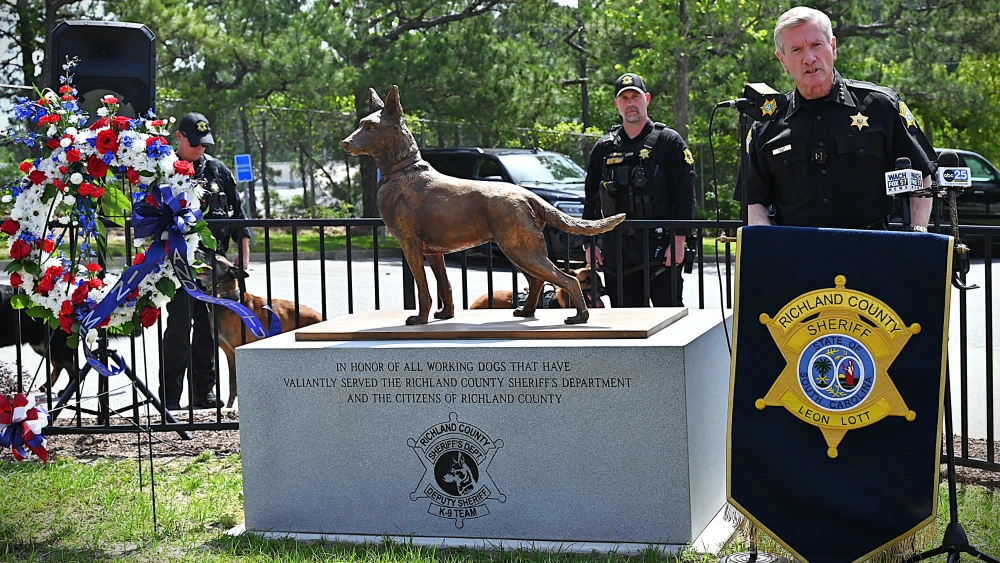Explore More
Honouring Loyalty and Courage: Richland County Sheriff’s Department and K-9 Sacrifices
The statue was officially unveiled on Thursday, May 15, National Peace Officers Memorial Day. Police K-9 units face rising fatalities and financial pressure in America as departments weigh the cost, emotional impact and operational necessity.

The rising casualties amongst police K-9 units across America reveal a troubling trend that goes far beyond individual tragedies. These highly trained animals represent significant financial investments for departments already stretched thin, making each loss a compound blow to public safety infrastructure.
Recent data from the Officer Down Memorial Page shows 21 K-9 line-of-duty deaths in 2024, with gunfire accounting for the majority of fatalities. This marks a concerning pattern that has been building over the past two decades, with research indicating K-9 deaths have increased significantly since 2000.
The financial implications alone are staggering. Training a street-ready K-9 unit costs up to £25,000 when factoring in the animal’s purchase, extensive training programme and equipment. For departments facing budget constraints and staffing shortages, replacing fallen K-9s creates immediate operational gaps that can take months to fill.
South Carolina’s Devastating Year
The scale of this challenge became particularly evident during the National Police K-9 Memorial Service held on 11 May at the National Law Enforcement Officers Memorial in Washington DC. Of the 22 deceased K-9s recognised nationally, five came from South Carolina alone – an unusually high concentration for a single state.
Three of those losses belonged to the Richland County Sheriff’s Department: Bumi, Kodak and Wick, each killed in the line of duty. Deputy Chief Maria Yturria noted the department suffered more K-9 losses than any other law enforcement agency in America for 2024. ‘Though one loss is one too many,’ she observed during the memorial ceremony.
Sheriff Leon Lott addressed the memorial’s broader significance during the unveiling of RCSD’s new K-9 memorial statue on 15 May. ‘This recognises both those K-9s we have lost to natural causes and those lost in the line-of-duty, the KIAs,’ he explained. ‘The sacrifices made both by the K-9s and their handlers must be recognised.’
The memorial includes special stars next to the names of K-9s killed in action, distinguishing them from those who died of natural causes. Unfortunately, RCSD has had to add four such stars, including Fargo who was shot and killed in 2011.
The Strategic Value Under Fire
Understanding why departments continue investing in K-9 units despite these risks requires examining their operational value. These animals significantly increase success rates in operations through superior detection capabilities for drugs, explosives and evidence that human officers might miss.
RCSD maintains approximately 25 K-9s across various specialisations: full-service patrol dogs for criminal apprehension and tracking, narcotics detection units, two explosive ordnance disposal dogs, one electronics-detection K-9 for computer crimes, and a search and recovery specialist. The department also operates ‘C.J.’, a crisis intervention K-9 that assists with emotionally disturbed individuals.
This diversification reflects the modern evolution of K-9 units beyond traditional patrol work. Comfort dogs are increasingly used for crisis intervention and supporting officers dealing with PTSD, expanding their value proposition for departments. This shift towards therapeutic applications demonstrates how understanding canine communication has advanced policing techniques.
The immediate deterrent effect cannot be quantified easily, but K-9 presence demonstrably prevents crime and strengthens community-police relationships. For smaller departments covering large geographical areas, these units provide force multiplication that human officers alone cannot match.
The Ongoing Threat
The dangers facing K-9 units showed no signs of abating even as RCSD commemorated their fallen animals. On 21 May, just six days after the memorial ceremony, another RCSD K-9 named Kiro was shot and wounded by a fleeing suspect in northeast Columbia. Both Kiro and his handler survived the subsequent exchange of gunfire, though the suspect was killed when the deputy returned fire.
This incident underscores the persistent threats these units face. Research examining K-9 deaths between 2000 and 2023 confirms gunfire as the leading cause of line-of-duty deaths, followed closely by heatstroke.
The pattern suggests criminals increasingly view K-9s as high-priority targets, understanding their tactical advantage in pursuits and investigations. This creates a troubling escalation where the very capabilities that make these units valuable also make them targets. For officers like those building legacies in law enforcement, protecting these partnerships becomes both professional and personal.
Investment Under Pressure
Despite mounting casualties, departments continue expanding K-9 programmes because the alternative – operating without these capabilities – poses greater long-term risks to public safety. The initial investment of £15,000 to £45,000 per dog plus training costs represents significant expenditure for budget-conscious departments.
However, the operational return justifies this investment through enhanced detection rates, successful tracking operations and crime deterrence effects that human officers cannot replicate. The challenge lies in protecting these valuable assets while maintaining their operational effectiveness. For officers transitioning between roles, such as those moving from police to peace work, these partnerships often represent the most meaningful aspects of their careers.
Memorial services like those held in Washington DC and Columbia serve multiple purposes beyond honouring fallen animals. They maintain public awareness of the sacrifices inherent in law enforcement work and reinforce the human-animal partnerships that define modern policing.
For Sheriff Lott, the hope remains simple: ‘My hope, prayer and dream is that we will never have another star [designating KIAs] added to this memorial.’ Yet the realities of modern law enforcement suggest this optimism may be tested as criminal elements continue targeting these highly trained partners.
The K-9 memorial funded by the non-profit K-9 Godmothers stands as more than ceremonial recognition. It represents an acknowledgment that effective policing requires investments in capabilities that criminals actively seek to neutralise, creating an ongoing cycle where departments must balance operational necessity against the human cost of losing these four-legged officers.




